
If you are one of those people who signed up to Google+ in the early days but find you do not use the social network on a regular basis, here are a few tools you should know about.
Several of these were discussed in a presentation given by Ian Barber, senior developer advocate at Google+, at last week's news:rewired conference.
You can see his presentation slides, which illustrate several of the tools, at this link.
1. Photo bylines
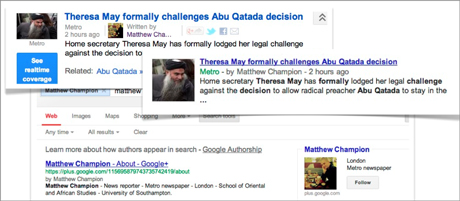
Taken from Ian Barber's presentation
It is a year since Google+ introduced photo bylines for journalists, a feature called 'Google authorship'.
Even if you have not set this up, you will no doubt be aware of picture bylines as they are displayed both in Google News and Google search results (see above image).
It takes a few minutes to set up a photo byline (if you have a Google+ account). Here are instructions on how to do it.
Five months after the launch of the authorship feature, a study found that 13 per cent of Google searches include journalist photo bylines.
2. Profile page
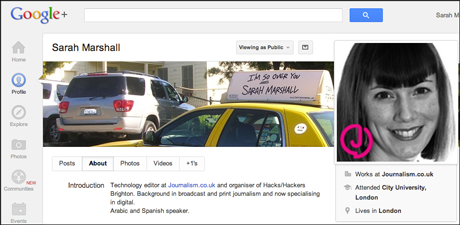
Google+ also gives journalists a profile page. It is worth paying attention to the information you enter as it enables people to find and contact you.
Journalists can be contacted via their profiles or use this feature to email potential sources or interviewees.
Contacting via a private message on Google+ may be preferable to using a public tweet when requesting an interview, for example.
The send message option does not appear by default. You will need to enable this to allow others to contact you. It is advisable to do this if you want to provide sources or other journalists with an easy way of contacting you.
If a person has enabled this option, you can contact them via the envelope logo to the right of their name, or use the "send an email" link below the details on their circles on the right of their profile.

In addition to adding a 'send message' button, which enables you to select how public you want to make the button (see above image), you can add your work email address to your profile.
3. Circles

Circles was an original feature of Google+. It allows you to group contacts by category. You can even add contacts not on Google+ to Circles. This allows you to create an email group, for example.
In his presentation at news:rewired, Barber said Circles can be used for "curating sources".
The link with other Google elements, like contacts, allows you to add notes on a particular source which are private to you, he explained. You can also "turn up the dial", he said, to get alerts from those who do not post frequently, therefore not missing out on a post from a key contact.
4. Explore
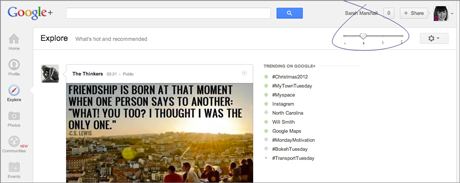
Explore allows you to see "what's hot and recommended" on Google+. It has a really useful dial allowing you to set just how many of the trending topic posts display in your timeline (see above).
The Explore feature could be a useful way of discovering new popular topics.
5. Ripples
Ripples is a tool that shows you how a story is being shared on Google+.
According to Google's description, "Ripples creates an interactive graphic of the public shares of any public post or URL on Google+ to show you how it has rippled through the network and help you discover new and interesting people to follow."
You can access Ripples by using the dropdown arrow on the top right of a post that appears in your stream. It will not show as an option on all posts at Ripples relies data being made public.
Another really handy way to use Ripples is to enter the URL of a story and see how it has been shared over time. For example, I entered the URL for this story published in June about the Financial Times reaching 1 million followers on Google+. I can see who shared it, how they are connected, and who read it.
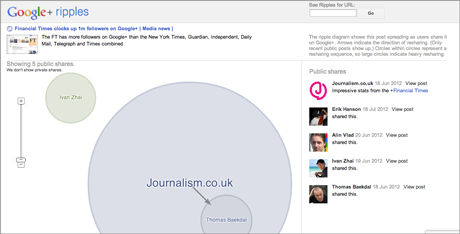
Access the Ripples URL search box using this link.
6. Hangouts
Hangouts have proved a real plus for journalists and news outlets. Many journalists have hosted Hangouts as a way of engaging with a community, researching a story or topic or broadcasting a debate. They are also being used for interviews, Barber explained.
Hangouts allow up to 10 people to appear in a video chat, with the On Air option broadcasting the conversation on Google+ and YouTube.
Yesterday social news agency Storyful hosted a Hangout On Air on verification, for example.
The New York Times, Time magazine, the Guardian and Al Jazeera have all held hangouts, to name just a few of the outlets making the most of this feature.
7. Apps in Hangouts
Hangouts also have huge potential for collaboration as you can run applications within Hangouts, Barber explained. For example, members of Hangouts can all view a YouTube video or access a Google Doc.
A Hangout could therefore be held by journalists based in different locations to collaborate on a project.
8. Communities
Communities is a new feature of Google+ and provides a discussion forum. Communities may well prove to be another real winner of Google+ as the feature allows for conversations and knowledge sharing.
Members and moderators can invite new people to the community and posts can be grouped by topic.
For example, take a look at this "Social Journalism" community set up by social media expert and trainer Sue Llewellyn. You can see the potential for rich debate and knowledge sharing.
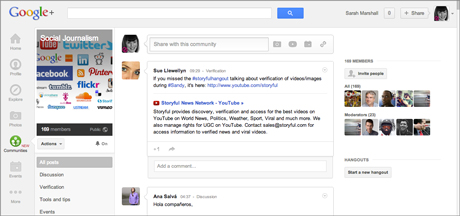
News outlets could also use the communities feature for user feedback.
Moderators can also control whether a community is public or private and members can decide whether or not to receive alerts when a member posts to the forum.
Related reading: 10 ways journalists can use Google+ (from a week after the social network launched so this does not include all features that are now available).
To suggest other ways journalists can use Google+, leave a comment below or on the Journalism.co.uk Google+ page.
Free daily newsletter
If you like our news and feature articles, you can sign up to receive our free daily (Mon-Fri) email newsletter (mobile friendly).









